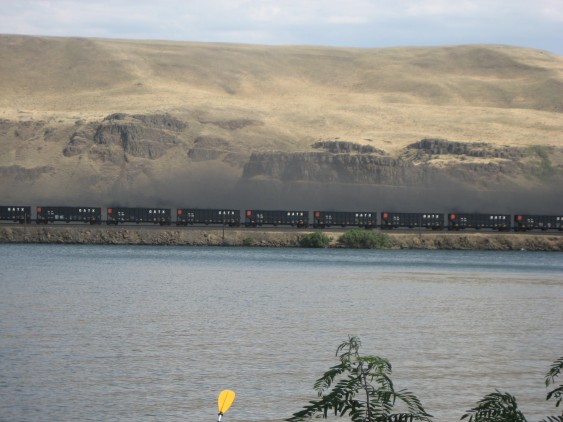It’s been a rough summer for coal trains.
There have already been at least 6 major headline-grabbing derailments, at least one of which was fatal. Then observers in the Columbia River Gorge snapped damning photos of coal trains passing through Columbia Hills State Park in Washington.
Here’s one:

That black cloud billowing above the train is almost certainly coal dust.* One would hope that photos like this should put to rest the coal industry’s nonsense that the shipments are clean. Clearly, there are direct and harmful impacts.
Many more photos are available on Columbia Riverkeeper’s Facebook page.
The coal dust was hardly the most egregious recent problem in the Northwest. That honor was taken on July 2 when a coal train derailed near the town of Mesa in eastern Washington; 31 overturned railcars spilled an estimated 6 million pounds of coal.
Less than a week earlier, a coal train had derailed near Junction City, Kansas sending 21 railcars off the tracks and spilling hundreds of tons of coal. In the days that followed the Mesa accident, things only got worse. A coal train derailed in Texas dumping 43 railcars worth of coal onto the ground. Then on July 4, a coal train derailed in Chicago sending 27 railcars crashing from an overpass onto a nearby street where they obliterated a car, killing the two people within. On July 10, a coal train derailed in Indiana. Then on July 15, another coal train went off the rails in Kansas. And on July 16 yet another derailed in North Carolina.
You don’t need to be alarmist to be concerned about the coal export proposals for the Northwest. Operating at full capacity they would bring roughly 29 loaded coal trains into the region each day, 365 days per year. Leaving aside the profound health and climate impacts of burning the coal, the trains themselves would pose a serious risk to public safety.
It’s a problem that demands a solution and yet, so far, the coal industry isn’t acknowledging that a problem exists.
Postscript: One commenter on Columbia Riverkeeper’s Facebook page alleges that the dust in the photograph is from petcoke, a fossil fuel derivative, and not coal. So far, repeated inquiries with BNSF about the precise contents have been met with silence. For more on this topic—including an assessment of whether it’s coal itself that’s causing the derailments—check out Peter LaFontaine’s take on it over at the National Wildlife Federation.
* Update 7/25/12: At the Oregonian, Scott Learn reports that: “… it wasn’t a coal train, BNSF spokeswoman Suann Lundsberg says — the railroad didn’t have any coal trains running past that spot at the time. But it might have been a petroleum coke train…” (Personally, I wish I were more confident in BNSF’s honesty.)
* Update 8/6/12: Yet another coal train derailment, this one on July 29 and it sparked a grass fire.
* Update 8/7/12: Over at NWF, Peter LaFontaine has put together an awesome “Coal Train Tracker” with an interactive map documenting coal train derailments in 2012.


Comments are closed.